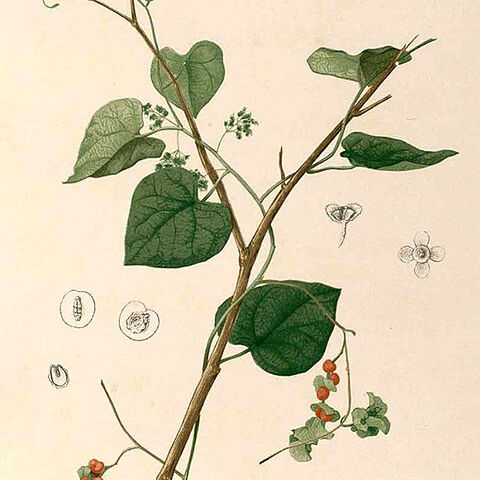Vines or erect shrubs. Leaf blade ovate, cordate, or rotund, peltate or not, palmately veined. Male inflorescences axillary, corymbose cymes, sometimes borne along a reduced shoot arising from axils of bracteal leaves, pedunculate. Male flowers: sepals 4, obovate, often pubescent adaxially, extended outward when blooming; petals connate into cup-shaped corolla, rarely 2-4-divided almost to base; stamens 4(-10), connate into a peltate synandrium. Female inflorescences thyrsoid, elongate, composed of fascicles; bracts usually accrescent and foliaceous, overlapping. Female flowers: sepal 1; petal 1(-3), opposite to sepal; carpel 1, often pubescent. Drupes subglobose, slightly flattened, often pubescent, style scar near base; endocarp crustaceous or ± bony, horseshoe-shaped, abaxially bearing conical or transverse ridges; condyle usually subglobose. Seed horseshoe-shaped; embryo elongate, terete, embedded in endosperm; cotyledons flattened, shorter than or equal to radicle.
Scandent shrubs or lianas. Leaves peltate or not peltate. Male inflorescences: flowers in axillary, peduncled, corymbose cymes, these solitary or fascicled (and sometimes borne along an axillary shoot bearing reduced leaves, but not normally so in Malesia). Male flowers: sepals 4, obovate; petals connate into a cupuliform corolla (rarely free in extra-Malesian spp.); stamens connate into a peltate synandrium, anther-cells 4 (in Malesian sp.). Female inflorescences axillary, thyrsoid, elongate, composed of fascicles arising in the axils of ac-crescent ± orbicular bracts (these not accrescent in some American spp.). Female flowers: sepal 1; petal 1 (rarely 2-3 in extra-Malesian spp.); staminodes 0; carpel 1. Drupe curved with style-scar near base, pubescent; endocarp bearing dorsally 2 rows of transverse ridges; seed horseshoe-shaped; embryo embedded in endosperm, elongate, narrow, terete, cotyledons flattened, radicle as long as or longer than the cotyledons.
Twining lianes, sometimes rambling shrubs. Leaves simple, peltate or subpeltate, entire or angular. Female inflorescences of corymbose cymules which are either solitary or clustered or arranged in ± developed false racemes. Male flowers with 4 (–5) obovate often spreading sepals; petals usually connate into a patelliform or cup-shaped corolla, sometimes incompletely connate; stamens connate into a 4–10-locular synandrium; antherthecae with longitudinal dehiscence. Female inflorescences less developed than the ♂; cymules 3–9-flowered, axillary or in false racemes, arising from the axils of leaves or of accrescent bracts. Female flowers with 1 sepal, rarely more; petal 1, rarely 2 or 3, smaller than the sepal, sometimes broader than long; carpel 1. Drupes with hairy or glabrous exocarp; mesocarp fleshy and thin; endocarp woody, with 1 dorsal ridge; the sides with small transverse often verrucose ribs. Seeds with a sparse endosperm.
Twining shrubs, rarely erect. Leaves alternate, petiolate, more or less peltate or basifixed. Staminate inflorescence axillary, generally fasciculate, normally originat-ing in a leafy axil as multiflowered dichasia or the dichasia originating on axillary secondary branches in the axils of reduced leaves or bracts. Staminate flowers 2-merous, actinomorphic: Sepals 4, usually exteriorly pubescent; petals connately cupulate; stamens 4, the anthers sessile on a column formed by the connate fila-ments, dehiscence transverse. Pistillate flowers fasciculate in the axils of reduced leaves or bracts upon secondary, frequently fasciculate, axillary branches, zygomor-phic: Sepal 1, obovate, exteriorly pubescent; petal 1, antesepalous; carpel 1, free, gibbose, the style short, the stigma 3-lobed. Drupes subglobose; endocarp osseous, verrucose, ribbed.
Scandent shrubs or woody climbers, without prickles. Leaves peltate (in Australia), palmately veined. Male inflorescences axillary, pedunculate, corymbose cymes, solitary or in fascicles. Male flowers: sepals 4, imbricate; petals connate into a cup-shaped corolla (in Australia); stamens connate into a peltate synandrium; anthers 4 (in Australia). Female inflorescences axillary, thyrsoid, elongate, composed of fascicles of flowers arising in the axils of accrescent, ± orbicular bracts (in Australia). Female flowers: sepal 1; petal 1 (in Australia); staminodes absent; carpel 1; stigma trifid. Drupe curved, pubescent, without stipe or carpophore; style-scar near base; endocarp bony, dorsally ridged or tuberculate. Seed horseshoe-shaped; embryo elongate, narrow, embedded in endosperm; cotyledons flattened, as long as or shorter than radicle.
Male flowers with 4 (5) obovate often spreading sepals; petals usually connate into a patelliform or cup-shaped corolla, sometimes incompletely connate; stamens connate into a 4–10-locular synandrium; anther-thecae with longitudinal dehiscence.
Female inflorescences less developed than the male cymules, 3–9-flowered, axillary or in false racemes, arising from the axils of leaves or of accrescent bracts.
Drupe with hairy or glabrous exocarp; mesocarp fleshy and thin; endocarp woody, with 1 dorsal ridge, the sides with small transverse often verrucose ribs.
Male inflorescences of corymbose cymules which are either solitary or clustered or arranged in more or less developed false racemes.
Female flowers with 1 sepal, rarely more; petal 1, rarely 2–4, smaller than the sepal, sometimes broader than long; carpel 1.
Leaves simple, peltate or sub-peltate, entire or angular.
Twining lianes or sometimes scandent shrubs.
Seeds with scanty endosperm.

